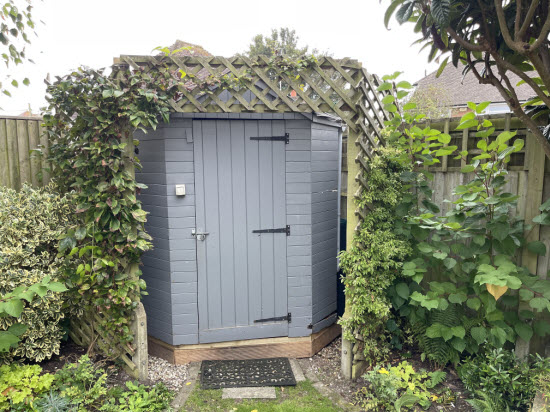The Secret Problem Hiding Beneath Your Garden Shed's Ivy
When my client sent over a photo of her shed last spring, it looked charming. Ivy had crept up the walls and arched gently over the roofline. It could have passed for a cottage garden scene from a calendar. But then came the close-ups. Ivy tendrils were weaving between the boards, pushing roof panels apart. What started as rustic charm had turned into structural sabotage.
 This ivy had become out of control. It probably looked lovely the previous summer but now the roof was in shreds and required a lot of work to make weather tight
This ivy had become out of control. It probably looked lovely the previous summer but now the roof was in shreds and required a lot of work to make weather tight
This is more common than you'd think. And the biggest issue? Most people don't see it coming until the damage is well under way.
Looks Lovely, Hides Trouble
There's a widespread belief that it's fine to let plants climb a shed. It softens the look, blends it into the garden, and in many cases, seems harmless. After all, plants grow on walls all the time, right?
Not quite. Garden sheds, unlike brick houses, are typically built from softwood timber-sometimes tongue and groove, sometimes shiplap, and often untreated at the rear or underside. They're not built to withstand the prolonged contact and pressure of a living, breathing plant like ivy.
And ivy doesn't just rest on the surface.
Ivy Is a Structural Opportunist
Ivy anchors itself with tiny rootlets that act like suckers. These rootlets latch onto anything they can, and timber provides plenty of grip. Worse, ivy is patient. It grows slowly but persistently, sneaking between overlapping boards or lifting roofing felt just enough to allow in moisture.
Over time, the plant begins to act like a slow-motion pry bar. Boards are pushed apart. Roof panels lift. The very shell of the shed becomes an entry point for water and insects.
What starts as greenery becomes a perfect setup for rot.
Moisture, Insects, and Weight
Once gaps form, dampness creeps in. Then, insects follow. Spiders, beetles, even wood-boring bugs set up shop in the now damp and dark interior. Add autumn rain and winter freeze-thaw cycles, and decay accelerates.
And it doesn't end there.
A mature ivy plant soaked from rain is heavy. That extra weight sits on the roof ridge, pulling down on the structure. More than one shed roof has caved in from the simple weight of wet vegetation. It's not dramatic; it just sags and then splits.
Think Distance, Not Denial
If you love the idea of greenery softening your garden buildings, there are safer options. You don't have to strip everything bare. The key is distance and airflow.
Here's what I recommend:
- Don't let plants grow directly against shed walls. Give the shed room to breathe, especially at the base where moisture lingers longest.
- Use freestanding trellises or supports. Position them a foot or so from the walls. You can still train plants to cover the shed area visually, but with airflow in between.
- Cut back vegetation in autumn. This prevents dampness from lingering on walls and reduces weight stress during wet months.
 The use of a trellis allows for the plants to hide the bulk of the shed without damaging the fabric of the building
The use of a trellis allows for the plants to hide the bulk of the shed without damaging the fabric of the building
The Shed That Got Away
That ivy-covered shed I mentioned at the start? It cost over £600 to repair the damage. Sections of wall had to be rebuilt, the roof re-felted, and some joists replaced where water had pooled below. And most of it could have been prevented with one clear foot of breathing room.
Garden sheds don't ask for much. But they do need to stay dry, and they need their seams and joints to stay closed. Ivy doesn't care about either.
So next time you see a shed with greenery snaking up its side, remember: It may look like a fairy tale, but there's often a rot story underneath.
Keep your shed green-free and sound. Give it space, and it will reward you with decades of quiet service.

Keep in touch with our monthly newsletter
Shed Building Monthly




